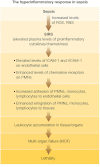New approaches to the study of sepsis
- PMID: 23208733
- PMCID: PMC3531600
- DOI: 10.1002/emmm.201201375
New approaches to the study of sepsis
Abstract
Models of sepsis have been instructive in understanding the sequence of events in animals and, to an extent, in humans with sepsis. Events developing early in sepsis suggest that a hyperinflammatory state exists, accompanied by a buildup of oxidants in tissues reflective of a redox imbalance. Development of immunosuppression and degraded innate and adaptive immune responses are well-established complications of sepsis. In addition, there is robust activation of the complement system, which contributes to the harmful effects of sepsis. These events appear to be associated with development of multiorgan failure. The relevance of animal models of sepsis to human sepsis and the failure of human clinical trials are discussed, together with suggestions as to how clinical trial design might be improved.
Copyright © 2012 The Authors. Published by John Wiley and Sons, Ltd on behalf of EMBO.
Figures



C5a is a rather oxidant-resistant glycosylated peptide with antiparallel helical structures.
The interaction of C5a with C5aR (CD88) triggers series of responses initiated by interaction of the cytoplasmic tail of C5aR with G-proteins, followed by engagement and activation of the signalling molecules, RAS, RAF-1, MEK1/2 and ERK1/2. An important response is activation of NADPH oxidase (NOX2) which is linked to the translocation of cytosolic subunits of NOX2 to the plasma membrane where NOX2 is assembled, facilitating electron transport and production of superoxide anion (
 ) and generation of H2O2, which accounts for the major bactericidal activity of activated PMNs. The presence of activated PMNs would result in inflammatory injury of organs.
) and generation of H2O2, which accounts for the major bactericidal activity of activated PMNs. The presence of activated PMNs would result in inflammatory injury of organs.
References
-
- Adrie C, Azoulay E, Francais A, Clec'h C, Darques L, Schwebel C, Nakache D, Jamali S, Goldgran-Toledano D, Garrouste-Orgeas M, et al. Influence of gender on the outcome of severe sepsis: a reappraisal. Chest. 2007;132:1786–1793. - PubMed
-
- Angus DC. The lingering consequences of sepsis: a hidden public health disaster. JAMA. 2010;304:1833–1834. - PubMed
-
- Angus DC. The search for effective therapy for sepsis: back to the drawing board. JAMA. 2011;306:2614–2615. - PubMed
-
- Angus DC, Linde-Zwirble WT, Lidicker J, Clermont G, Carcillo J, Pinsky MR. Epidemiology of severe sepsis in the United States: analysis of incidence, outcome, and associated costs of care. Crit Care Med. 2001;29:1303–1310. - PubMed
-
- Bagshaw SM. Short- and long-term survival after acute kidney injury. Nephrol Dial Transplant. 2008;23:2126–2128. - PubMed
Publication types
MeSH terms
Substances
Grants and funding
LinkOut - more resources
Full Text Sources
Other Literature Sources
Medical

